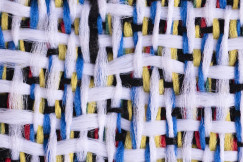Best practices
09 May 2025
Circular Innovation in the Prato Textile District
Best practices
09 May 2025
Infrastructure
Investments and funding
R&I, techniques and technological solutions
+4 more
Login / create an account to be able to react
-
102

Prato textile district in Tuscany, Italy, has established itself as a European leader in textile recycling innovation. Operating through an interconnected network of specialized companies, the district processes both pre-consumer and post-consumer textile waste. The district is now investing in a new technologically advanced recycling hub, which will process 34,000 tonnes of material yearly using AI and infrared technology for automated sorting. Set to begin operations by mid-2026, this facility will enhance the district's circular economy capabilities by enabling more efficient processing of previously challenging materials.
CNA - Confederazione Nazionale dell'Artigianato e della piccola e media impresa
Topics
Italy
Academic / Research and VET Institutions
Business Support Organisation
Company with 250 or more employees
Cluster Organisations
Consumer Organisations
Industry Associations and Chambers of Commerce
National authorities
Networks and Federations / Confederations
NGOs / Non-profits
Regional Authorities
SMEs (a company with less than 250 employees)
-
Transition Pathway's building blocks
-
-
Infrastructure
-
Investments and funding
-
R&I, techniques and technological solutions
-
Sustainable competitiveness
-
-
Industrial ecosystems
-
-
Textile
-
-
Textiles ecosystem areas
-
-
Fibres, yarns and fabrics
-
Waste management, reuse and repair
-
Share
The Prato Textile District
Located in Tuscany, Italy, the Prato textile district stands as one of Europe’s most important textile manufacturing centres. The district is home to thousands of companies, covering the entire textile value chain — from spinning and weaving to finishing and garment production. Today, Prato is internationally recognised as a model of innovation in textile recycling, particularly in the reuse of textile processing waste and second-hand clothes, with a special emphasis on wool materials.
Recycling Activities: A District-Wide Commitment
The Prato district is globally acknowledged as a pioneer in textile recycling. Leveraging centuries-old techniques combined with modern innovation, companies across Prato have developed advanced methods to recover fibres. The district functions through an interconnected network of businesses that collectively participate in the production and distribution of recycled fabrics. Each enterprise specializes in one segment of the manufacturing process—whether spinning, warping, weaving, dyeing, finishing, printing, or designing—creating a comprehensive ecosystem for material transformation.
What distinguishes Prato's approach is its management of both pre-consumer waste (manufacturing scraps) and post-consumer waste (used garments). Approximately 100 companies within the district specialize in recovering over 100,000 tonnes of material annually from these streams, with wool recycling at the heart of these efforts.
When used clothing arrives at one of the district's 50 specialized first plants, it undergoes careful sorting and processing. About 65% of incoming materials are directed to reuse, 33% to recycling, with only 3-4% ultimately sent for disposal. The economic impact of these recycling activities is substantial, generating approximately 20% of the district's total turnover.
The New Textile Recycling Hub: A Strategic Infrastructure for the District
Recognizing the need to further strengthen its leadership in sustainable textile manufacturing, Prato is investing €29.5 million in a new textile recycling hub. This strategic infrastructure project, co-funded by the Italian Recovery and Resilience Fund, represents a collective commitment to advancing the district's circular economy capabilities.
The hub, scheduled to begin operations by mid-2026, will centralize and enhance key recycling functions across the district. With the capacity to process 33,000 tonnes of material annually—20,000 tonnes from post-consumer sources and 13,000 tonnes from pre-consumer waste—it will significantly expand the district's recycling capacity.
What makes this facility particularly innovative is its technological sophistication. Automatic sorting systems combining artificial intelligence and sophisticated infrared technology will separate materials by fibre type and colour. This will dramatically improve efficiency and enable the recovery of materials that were previously difficult to process manually. The hub will also include pre-tearing lines to prepare materials for mechanical recycling, ensuring that even challenging textile waste can be transformed into valuable new resources.
For post-consumer materials, the facility will enable about 60% (12,000 tonnes) of incoming garments to be sanitized and directed to specialized companies for reuse. The remaining 40%, consisting of non-reusable garments, will have components like zippers and buttons removed before undergoing sorting and processing. Similarly, pre-consumer waste that currently often ends up in landfills or incinerators will be systematically processed to recover usable fibres.
The project also includes the construction of a recovery plant with two warehouses for non hazardous special waste from textile waste and used clothing. One warehouse will house the storage areas for incoming and intermediate waste, the automatic and semi-automatic sorting lines for textile waste, as well as the presses for reducing the volume of the products. A second warehouse will house a shredding line and part of the intermediate waste storage facilities. The waste produced during processing will be stored in a shed next to this building.
A Model for Industrial Sustainability
As the global textile industry faces increasing pressure to address its environmental footprint, Prato stands as proof that government support for infrastructure development, combined with business-led operations, creates a powerful engine for sustainable industrial transformation.
Through its collective recycling initiatives and continued investment in advanced infrastructure, Prato is not only preserving its rich textile heritage but also creating a blueprint for how traditional manufacturing sectors can thrive in a resource-constrained future. As the new recycling hub becomes operational and technologies continue to advance, Prato's model will likely become even more influential in shaping sustainable manufacturing practices worldwide.
Comments (0)
See also
-
19
Welcome to the 'Competitive and Innovative Supply Chains' Workspace
- Categories
- Infrastructure Investments and funding R&I, techniques and technological solutions +16 more
-
3
Welcome to the Skills and Talent Community Workspace!
- Categories
- Infrastructure Investments and funding R&I, techniques and technological solutions +28 more
-
7
Building skills for the future: The EU’s sectoral blueprint approach
- Categories
- Infrastructure Investments and funding R&I, techniques and technological solutions +28 more




